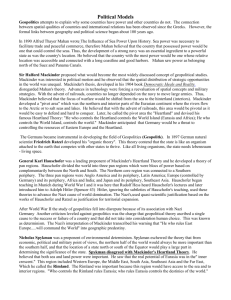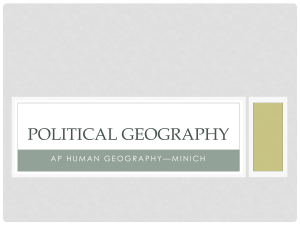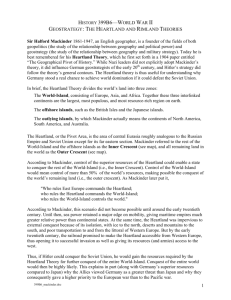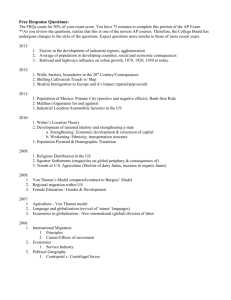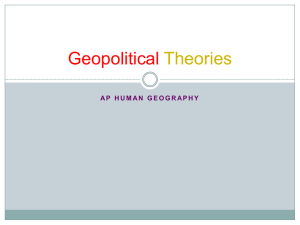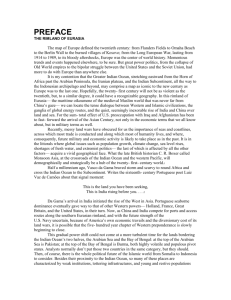- International Journal of Applied Research
advertisement
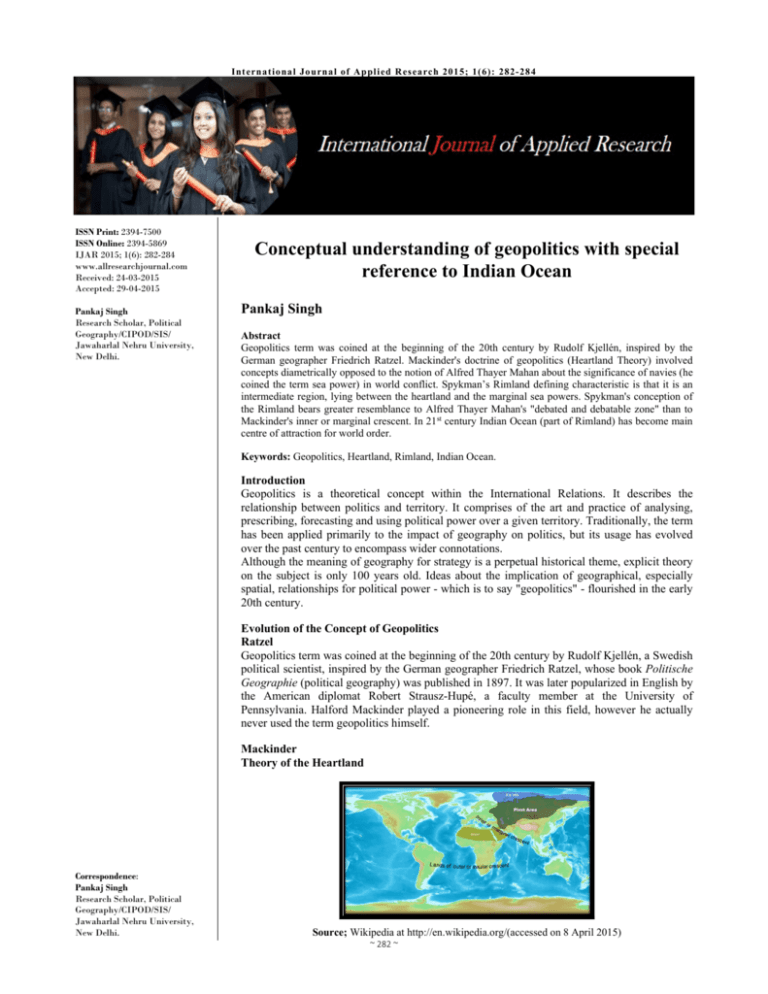
Int ernational Jo urna l of Appl ied R esearch 2015; 1(6): 282-284 ISSN Print: 2394-7500 ISSN Online: 2394-5869 IJAR 2015; 1(6): 282-284 www.allresearchjournal.com Received: 24-03-2015 Accepted: 29-04-2015 Pankaj Singh Research Scholar, Political Geography/CIPOD/SIS/ Jawaharlal Nehru University, New Delhi. Conceptual understanding of geopolitics with special reference to Indian Ocean Pankaj Singh Abstract Geopolitics term was coined at the beginning of the 20th century by Rudolf Kjellén, inspired by the German geographer Friedrich Ratzel. Mackinder's doctrine of geopolitics (Heartland Theory) involved concepts diametrically opposed to the notion of Alfred Thayer Mahan about the significance of navies (he coined the term sea power) in world conflict. Spykman’s Rimland defining characteristic is that it is an intermediate region, lying between the heartland and the marginal sea powers. Spykman's conception of the Rimland bears greater resemblance to Alfred Thayer Mahan's "debated and debatable zone" than to Mackinder's inner or marginal crescent. In 21st century Indian Ocean (part of Rimland) has become main centre of attraction for world order. Keywords: Geopolitics, Heartland, Rimland, Indian Ocean. Introduction Geopolitics is a theoretical concept within the International Relations. It describes the relationship between politics and territory. It comprises of the art and practice of analysing, prescribing, forecasting and using political power over a given territory. Traditionally, the term has been applied primarily to the impact of geography on politics, but its usage has evolved over the past century to encompass wider connotations. Although the meaning of geography for strategy is a perpetual historical theme, explicit theory on the subject is only 100 years old. Ideas about the implication of geographical, especially spatial, relationships for political power - which is to say "geopolitics" - flourished in the early 20th century. Evolution of the Concept of Geopolitics Ratzel Geopolitics term was coined at the beginning of the 20th century by Rudolf Kjellén, a Swedish political scientist, inspired by the German geographer Friedrich Ratzel, whose book Politische Geographie (political geography) was published in 1897. It was later popularized in English by the American diplomat Robert Strausz-Hupé, a faculty member at the University of Pennsylvania. Halford Mackinder played a pioneering role in this field, however he actually never used the term geopolitics himself. Mackinder Theory of the Heartland Correspondence: Pankaj Singh Research Scholar, Political Geography/CIPOD/SIS/ Jawaharlal Nehru University, New Delhi. Source; Wikipedia at http://en.wikipedia.org/(accessed on 8 April 2015) ~ 282 ~ International Journal of Applied Research Sir Halford Mackinder's Heartland concept showing the situation of the "pivot area" established in the Theory of the Heartland. The concept of geopolitics initially gained attention through the work of Sir Halford Mackinder in England and his formulation of the Heartland Theory which was set out in his article entitled "The Geographical Pivot of History" in 1904. Mackinder's doctrine of geopolitics involved concepts diametrically opposed to the notion of Alfred Thayer Mahan about the significance of navies (he coined the term sea power) in world conflict. (Diskhit 2006:176) The Heartland theory hypothesized the possibility of a huge empire being brought into existence in the Heartland, which wouldn't need to use coastal or transoceanic transport to remain coherent. The basic notions of Mackinder's doctrine involve considering the geography of the Earth as being divided into two sections, the World Island or Core, comprising Eurasia and Africa; and the Periphery, including the Americas, the British Isles, and Oceania. Not only was the Periphery noticeably smaller than the World Island, it necessarily required much sea transport to function at the technological level of the World Island, which contained sufficient natural resources for a developed economy. Also, the industrial centres of the Periphery were necessarily located in widely separated locations. (Jonshton 2006:52) [8]. The World Island could send its navy to destroy each one of them in turn. It could locate its own industries in a region further inland than the Periphery could, so they would have a longer struggle reaching them, and would face a well-stocked industrial bastion. Mackinder called this region the Heartland. It essentially comprised Ukraine, Western Russia, and Mitteleuropa (a German term for Central Europe). The Heartland contained the grain reserves of Ukraine, and many other natural resources. (Akerman 1954:67) [1]. Mackinder's notion of geopolitics can be summed up in his saying "Who rules East Europe commands the Heartland. Who rules the Heartland commands the World-Island. Who rules the World-Island commands the World." His doctrine was influential during the World Wars and the Cold War, for Germany and later Russia, each made territorial strides toward the Heartland. Nicholas John Spykman Nicholas John Spykman known as the "godfather of containment." In his writings concerning geography and foreign policy, Spykman was somewhat of a geographical determinist. Since geography was "the most fundamentally conditioning factor because of its relative permanence," it was of primary relevance in analyzing a state's potential foreign policy. (Sepma 2002:11) Spykman could be considered as a disciple and critic of both geo-strategists Alfred Mahan, of the United States Navy, and Halford Mackinder, the British geographer. Spykman’s work is based on assumptions similar to Mackinder: the unity of world politics, and the unity of the world sea. He extends this to include the unity of the air. It will affect the alignment of nations throughout the world's regions. Maritime mobility opened up the possibility of a new geopolitical structure: the overseas empire. Spykman adopts Mackinder's divisions of the world, renaming some: The Heartland; The Rimland (analogous to Mackinder's "inner or marginal crescent"); and The Offshore Islands & Continents (Mackinder's "outer or insular crescent"). At the same time, because he gives credit to the strategic importance of maritime space and coastal regions, Spykman's analysis of the heartland is markedly different from Mackinder's. He does not see it as a region which will be unified by powerful transportation or communication infrastructure in the near future. As such, it won't be in a position to compete with the United States' sea power. Spykman agrees that the heartland offers a uniquely defensive position, but that is all Spykman grants the occupier of the heartland. (Dodds 2006:65) [6] While the USSR encompassed a great expanse of land, its arable land remained in a small portion of its territory, mostly in the West. Indeed, the Soviet's raw materials were largely located to the West of the Ural Mountains as well. Since the political and material centre of gravity was in the Western part of the USSR, Spykman sees little possibility of the Soviets exerting much power in Central Asia. (Gary 2001: 99) [7] Rimland The Rimland (Mackinder's "Inner or Marginal Crescent") was divided into three sections: The European coast land; The Arabian-Middle Eastern desert land; and, The Asiatic monsoon land. While Spykman accepts the first two as defined, he rejects the simple grouping of the Asian countries into one "monsoon land." India, the Indian Ocean littoral and Indian culture were geographically and civilizationally separate from the Chinese lands. The Rimland's defining characteristic is that it is an intermediate region, lying between the heartland and the marginal sea powers. As the amphibious buffer zone between the land powers and sea powers, it must defend itself from both sides, and therein lay its fundamental security problems. Spykman's conception of the Rimland bears greater resemblance to Alfred Thayer Mahan's "debated and debatable zone" than to Mackinder's inner or marginal crescent. (Sloan 2003:78) The Rimland has great importance coming from its demographic weight, natural resources, and industrial development. Spykman sees this importance as the reason that the Rimland will be crucial to containing the Heartland (whereas Mackinder had believed that the Outer or Insular Crescent would be the most important factor in the Heartland's containment). There are two offshore continents flanking Eurasia: Africa and Australia. Spykman sees the two continents' geopolitical status as determined respectively by the state of control over the Mediterranean Sea and the "Asiatic Mediterranean." Neither has ever been the seat of significant political power — chaos prevents Africa from harnessing the resources of its tropical regions; Australia hasn't enough arable territory to serve as a base of power. Other than the two continents there are offshore islands of significance: Britain and Japan, while the New World is buffered by the Atlantic and Pacific Oceans. (Patrick 2005:56) Spykman recalls Mackinder's famous dictum, But disagrees, refashioning it thus as: Who controls the Rimland rules Eurasia; Who rules Eurasia controls the destinies of the world. ~ 283 ~ International Journal of Applied Research Indian Ocean Rimland consists of Indian Ocean littoral countries. Therefore we can say that one, who controls the Indian Ocean, will control the world. Spykman’s assumption has become the reality of the world order. Indian Ocean has been become very relevant in the 21st century. World powers want to control the Indian Ocean. Therefore geopolitics of Indian Ocean has also become the hotspot among US, China and India. Geopolitical conditions influence all strategic behaviour - even when co-operation among different kinds of military power is expected as the norm, action has to be planned and executed in specific physical environments. The geographical world cannot be avoided, and it happens as "organized" into land, sea, air and space - and possibly the electromagnetic spectrum including "cyberspace." (Cohen 2008:211) The Indian Ocean is back in fashion in the international geopolitical discourse. The current strategic excitement about the Indian Ocean is similar to the one more than four decades ago, when Great Britain announced the withdrawal of its forces from the East of the Suez. Then and now, the big question is about the meaning and consequences of a power in transition in the Indian Ocean. In the late 1960s, there was no doubt on who might replace Great Britain as the dominant power in the Indian Ocean. The only issue then was how the United States would organize itself to manage the affairs of the Indian Ocean. (Parker 2009:121) The change of guard four and a half decades ago was a relatively smooth one, for it shifted the burden of securing the Indian Ocean from one Anglo-Saxon power to another. It was also quite quick and put an end to the debate about the strategic future of the Indian Ocean. The current power transition could be longer and more destabilizing. In the first half of the 20thcentury, China and India were elevating their international standing through economic globalization and regional integration. Soviet Russia disconnected itself from the world economy as it rose. China and India are deepening their ties with the world economy as they become major powers. Their extraordinary international exposure today is marked by the fact that trade forms nearly 70 per cent of China’s GDP and closer to 35 per cent and rising in India. Unlike Russia which tried to build an alternative economic model and limit its contacts with the world capitalist system, China and India are becoming privileged members of an economic order that they once denounced with some passion. That they are members of the G-20 is less important than the possibility that China and India are emerging as important sources of the world economic growth and the drivers of regional integration in the Pacific and the Indian Ocean. (Chapman 2009: 111) The increase in the economic mass of China and India will intensify their gravitational pull and most certainly reconfigure the geopolitical space in the littoral of the Indian Ocean and the Asia Pacific. This would mean a restructuring of the relationships among major powers and regional actors. The most important ‘strategic triangle’ in littoral and the maritime world will be that between the United States, China and India. (Bose 2006:321) [2] 3. Champman A. Asia-Pacific geopolitics: hegemony vs. human security, New York: Edward Elgar Publishing, 2006. 4. Cohen, Stephen Philip. The Idea of Pakistan, Washington, D.C.: Brookings Institution press, 2004. 5. Dixit JN. Assignment Colombo, Vijita Yapa Bookshop, Colombo: Oxford University press, 1998. 6. Dodds S. The New Landscape of Indian Ocean Conflict, Colombo: Oxford University press, 2006. 7. Gary G. “Maritime Access and Maritime Power: The Past, the Persian Gulf, and the Future” Georgetown University, Sage Publications, 2001. 8. Jonshton, Dennis, Chaturvedi, Sanjay. Geopolitical Orientations, Security and Regionalism in the Indian Ocean, New Delhi: Orient Longman, 2006. 9. Panikkar KM. India and the Indian Ocean: An Essayon the Influence of Sea Power on Indian History, Bombay: George Allen and Unwin press 1961. 10. Pannikar KM. India and the IO, London: Oxford University Press, 1945. 11. Parker S. Geopolitical Orientations in the Indian Ocean, New Delhi: South Asian Publication, 2008. 12. Sepma. The Indian Ocean, London: Oxford University Press, 2003. 13. Solan P. From Free Oil to Freedom Oil, Canbera: David j. k. Press, 2007. References 1. Ackerman A. The British Empire in the Indian Ocean, New Delhi: Orient Longman, 1954. 2. Bose S. Ecolonization and State Building in South Asia, Journal of International Affairs 2006; 58(1):95-113. ~ 284 ~
